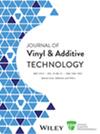Enhancing mechanical and thermal properties of rigid poly(vinyl chloride) composites via stearic acid-treated zinc oxide filler
Abstract
Rigid poly(vinyl chloride) (PVC) exhibits limitations in mechanical performance and thermal stability. The aim of this study is to develop composite and nanocomposite materials with enhanced properties using zinc oxide (ZnO) as a filler to address the limitations of rigid PVC. The objective is to produce a cost-effective material with improved thermal stability and mechanical properties. To enhance dispersion and compatibility with PVC, the ZnO filler was surface-treated with stearic acid through a mechanical treatment process. The PVC/ZnO composites were prepared via melt mixing using a Brabender plastograph. The Fourier transform infrared spectroscopy and x-ray diffraction results indicate that the surface treatment significantly altered the ZnO microstructure, leading to improved ispersion within the PVC matrix. Consequently, this modification resulted in enhanced properties of the rigid PVC, with a notable improvement observed at a ZnO filler content of 2 wt%. The thermogravimetric results indicated that treated ZnO increased the thermal stability of PVC composites. The mechanical test (Tensile Testing) reveals that highest modulus of elasticity (2.8 GPa), tensile strength (41 MPa), and elongation at break (38%) was obtained with modified ZnO incorporation.
Highlights
- Stearic acid improved ZnO filler dispersion and compatibility in rigid PVC.
- Treated PVC/ZnO composites showed better thermal stability and mechanical properties.
- FTIR, XRD, and TGA confirmed the surface treatment's impact on composites.


 求助内容:
求助内容: 应助结果提醒方式:
应助结果提醒方式:


